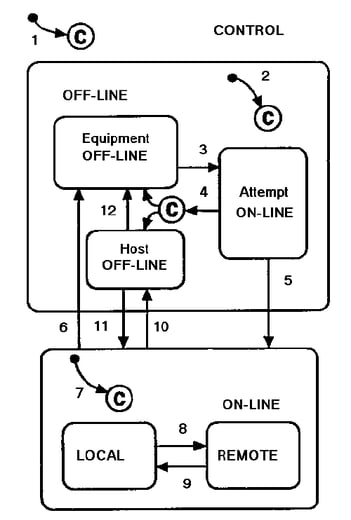What is GEM Control State?
The GEM Control State is one of the fundamental E30 GEM requirements. It defines the level of cooperation between the host and equipment and specifies how the operator may interact at the different levels of host control.
In a semiconductor factory, the host or operator may be in control of equipment processing. Having both sides in control of the equipment at the same time poses problems. When one side is in control of the equipment, the other side should be limited in the operations it can perform. For example, if an operator pauses processing, the host should not be allowed to send commands to resume processing or to start a new job. The GEM Control State is provided to prevent these types of issues from occurring.
 Figure 1: SEMI E30 GEM Control State Model
Figure 1: SEMI E30 GEM Control State Model
How does the Control State work?
The Control State provides three basic levels of control. Each level describes which operations may be performed by the host and equipment sides.
Remote
- The host may control the equipment to the fullest extent possible.
- The equipment may impose limits on the local operator’s ability to control the equipment, but this is not a requirement of the standard. The host must be capable of handling unexpected commands invoked by the operator at the equipment.
- GEM Remote Commands are used by the host to invoke commands on the equipment.
Local
- The operator may control the equipment to the full extent possible.
- The host has full access to information. The host can collect data using other GEM features such as collection events, traces, and status data collection.
- Limits are placed on how the host can affect equipment operations:
- Remote commands that initiate processing (e.g. START) or cause physical movement are prohibited. During processing, remote commands that affect processing (STOP, ABORT, PAUSE, RESUME) are also prohibited.
- Other remote commands that do not initiate processing, cause physical movement, or affect processing may be allowed.
- During processing, the host is prohibited from modifying any equipment constants that affect that process.
- Equipment constants that do not affect the currently running process may be changed.
- All equipment constants are changeable when not processing.
Offline
- The operator has complete control of the equipment.
- The host has no control over equipment operations and very limited information gathering capabilities.
- The only messages that the equipment will accept from the host are:
- Messages used to establish GEM communication (S1F13/F14).
- Requests to activate Online Control State (S1F17), but only if the currently active state is Host Offline (transition #11 on the Control State Model).
- S1F2 “Are You There Response” while the attempting to go Online.
- The only primary messages that the equipment may send to the host are:
- Messages used to establish communications (S1F13).
- S9Fx messages, but only in response to the messages to which the equipment will normally respond to while Offline (i.e., S1F13 and S1F17).
- S1F1 “Are You There Request” is sent to the host when the “Attempt ON-LINE” sub-state is entered. This message is used to get permission from the host to transition into an Online state (transition #5).
- No messages are spooled while Offline.
The Control State Model was designed in a way to give the equipment operator more control over the state machine than the host. This protects the operator from unexpected state changes initiated from the host.
- The equipment operator can choose which Online sub-state is active through the operator interface. The host side cannot choose which Online sub-state is active.
- The equipment side can put the Control State Model into an Equipment Offline state (transition #6). When in this state, the host cannot request to go Online.
- The host side can put the Control State into a Host Offline state (transition #10), but the equipment side could reject this request. When in the Host Offline state, the equipment side can always attempt to go Online by first transitioning into the Equipment Offline state (transition #12) followed by an attempt to go Online (transition #3).
Operator Interface Requirements
The equipment must provide a way of displaying the current Control State to let the operator know who is in control of the equipment.
The equipment must provide a momentary switch to initiate the transition to the Equipment Offline state, and another switch to attempt to go Online from the Equipment Offline state. This may be a hardware switch on the front panel, but is often implemented in software using button controls.
The equipment must provide a discrete two-position switch which the operator may use to indicate the desired Online sub-state (Local or Remote). This may be a hardware switch on the front panel, but is often implemented in software using button controls. If implemented in software, the setting must be saved in non-volatile storage.
Conditional State Transitions
In the Control State Model, transitions #1, #2, #4, and #7 are conditional state transitions. The equipment application must provide a way of configuring which state to transition into. Equipment constants may be used for these configuration settings.
Conditional transitions #1 and #2 determine the initial state of the Control State Model during startup. The configuration that controls these transitions can be set for one of the following states:
- Online
- Equipment Offline
- Attempt Online
- Host Offline
Conditional transition #4 is used to determine which state to transition into after an equipment attempt to go Online fails. The configuration can be set to one of the following states:
- Equipment Offline
- Host Offline
Conditional transition #7 is used to determine which Online sub-state (Local or Remote) should be active when the Control State becomes Online. The configuration can be set to one of the following Online sub-states:
- Local
- Remote
Which Messages are used for Control State?
|
Message ID |
Direction |
Description |
|
S1F1 |
Host <- Equipment |
This message is sent to the host when the equipment attempts to go Online (in the “Attempt ON-LINE” state). The host grants permission by sending the S1F2 reply message. The host can deny permission by sending S1F0 or allowing the message transaction to time out. |
|
S1F15 |
Host -> Equipment |
The host sends this message to request a transition from “Host Offline” to Online (transition #11). |
|
S1F17 |
Host -> Equipment |
The host sends this message to request a transition from Online to “Host Offline” (transition #10). |
Click here to read the other articles in our SECS/GEM Features and Benefits series.
To download a white paper with an introduction to SECS/GEM, Click below:





